You did it! You finally bought yourself that beautiful succulent plant that everyone says is so easy to grow. But now, just a short time later, it is looking so sad! The harder you try, the worse it looks… Could it be that Pinterest and Instagram are wrong, or is it just you? Not to worry – this post will give you all the information you need to get that plant healthy and happy again. You can learn how to water succulents – I promise!
The magic and mystery of succulents bewitching! But how to water succulents is an important question that does not have an easy answer of X amount of water every Y days. Because the single most common cause of death for these easy-care beauties is improper watering, it is important to get this right. Let’s tackle it together!
How to Water Succulents
In this Post We'll Cover:
{Please note, some links in this post may be affiliate links to sites that pay me a small commission if you click on the link and make a purchase. This commission is at absolutely no cost to you. I only recommend products and companies that I have worked with and truly love! ~Kat}
What is a Succulent?
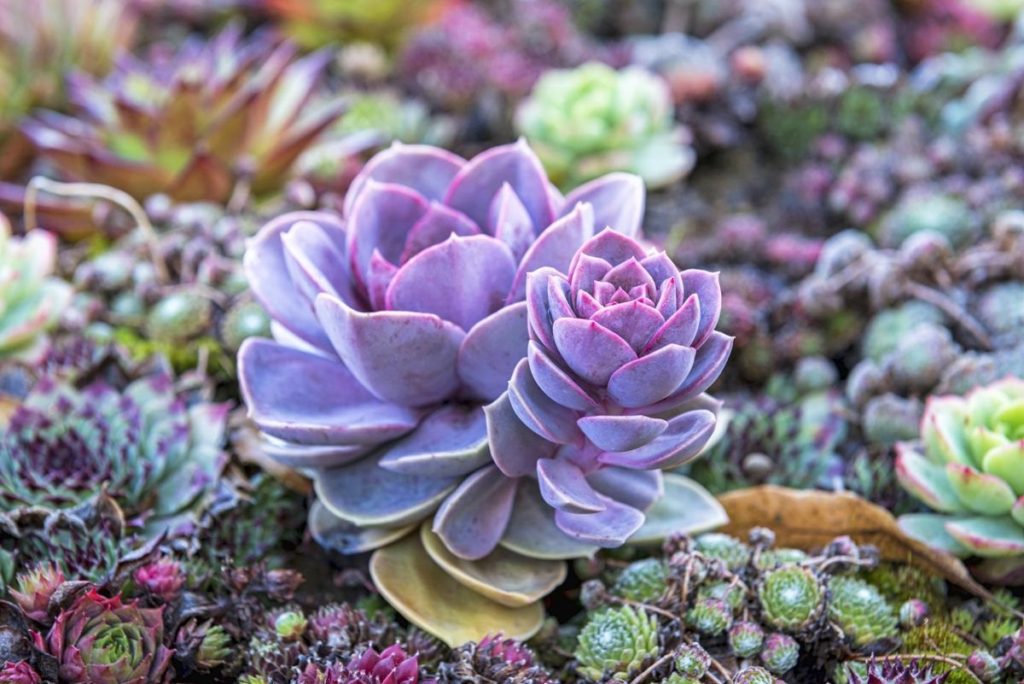
Succulents are a huge family of plants with a wide array of colors, forms, textures and sizes. Found in many parts of the world, succulents all have adapted to very dry conditions by developing specialized structures that enable them to store water in their leaves, stems and roots. The succulent draws upon the stored moisture enabling it to thrive in times of severe drought. Think about these structures as a series of teeny, tiny water balloons in each succulent plant. A healthy succulent takes up water through its roots and fills each water storage cell. The “water balloons” swell to their fullest, and retain this moisture until it is needed.
The defining characteristic of succulent plants is that they have adapted to be able to thrive where water is scarce. This tells us that dry conditions are what they are adapted to, so it is better to err on the side of under watering succulents rather than overwatering.
When to Water Succulents, and When to Leave Them Dry
The adaptation that enables succulents to store water when it is plentiful for later use when it is scarce tells us that it is FAR better to leave a succulent plant too dry rather than too wet. They have adapted to survive drought conditions. While it can take months for a succulent to truly die from lack of water, and overwatered succulent can die within days.
Signs Your Succulent Needs Water
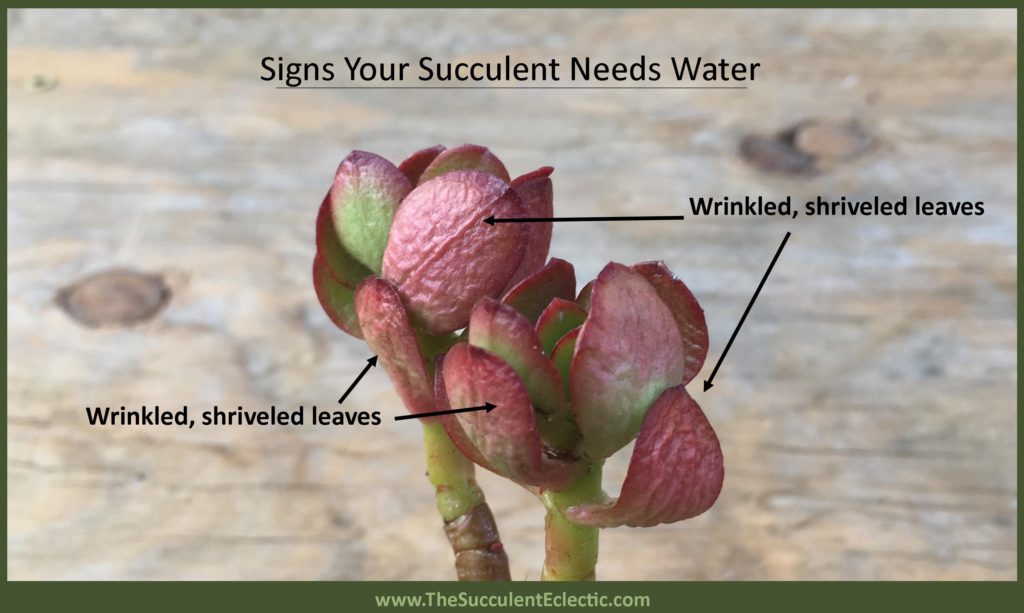
While it is better to leave your succulent too dry than too wet, that does not mean you should never water it. Just like any other plant, your succulent needs water to be healthy. When the plant is in a sustained period of drought, it draws upon the moisture stored in its leaves. The “water balloons” begin to deflate as the stored water is drawn down without being replaced. In time, the leaves will become wrinkled, and shriveled, as the once fully inflated storage cells lose water and begin to shrink. Leaves that were firm and plump start to collapse and shrivel and may droop down. In the image above, you can see what the leaves look like when the plant’s need for water becomes urgent. This is a clear sign that your succulent plant needs more water.
When watering succulents, be thorough. Drench the soil until the excess water flows from the drainage holes in the container. You want to mimic the heavy, sudden rains that occur where succulents are native. Then, follow the soil-drenching water with a long period letting the soil dry out. This “drench then drought” cycle is what has driven succulents’ evolution for millennia. Once you give it the water it needs, the storage cells fill up again, replenishing their stores of moisture, and the leaves plump up again. While stressful, this drought period was not damaging to the plant.
How to Water Succulents? Deeply, But Not Too Often
Deep watering promotes healthy root development. Watering succulents should follow the “drench then drought” cycle described above. This provides the plant with a familiar pattern it finds in nature and encourages healthy development. If the succulent is potted with good drainage, you can water from the bottom. Set the container in a tray of water, and allow the soil to wick up water for about five minutes. Remove the pot from the water and let it drain. The soil should fully dry before you water it again, which will likely take a week or more. If the succulent is growing in the ground, or in a container too heavy to move, water slowly at the soil line, rather than from overhead. Be thorough, but do not allow the plant to remain in waterlogged soil. Empty any catch trays after five minutes, and allow the soil to fully dry.
Signs Your Succulent is Over Watered
Storing water in its leaves, roots and stems enables succulent plants to survive hot, dry conditions. Healthy plants draw on these reserves to meet the plant’s needs and then replenishes these stores when rain or irrigation comes again. The “water balloons” fill, leak down and refill when more moisture is available. This system is crucial for the plant’s health and survival.
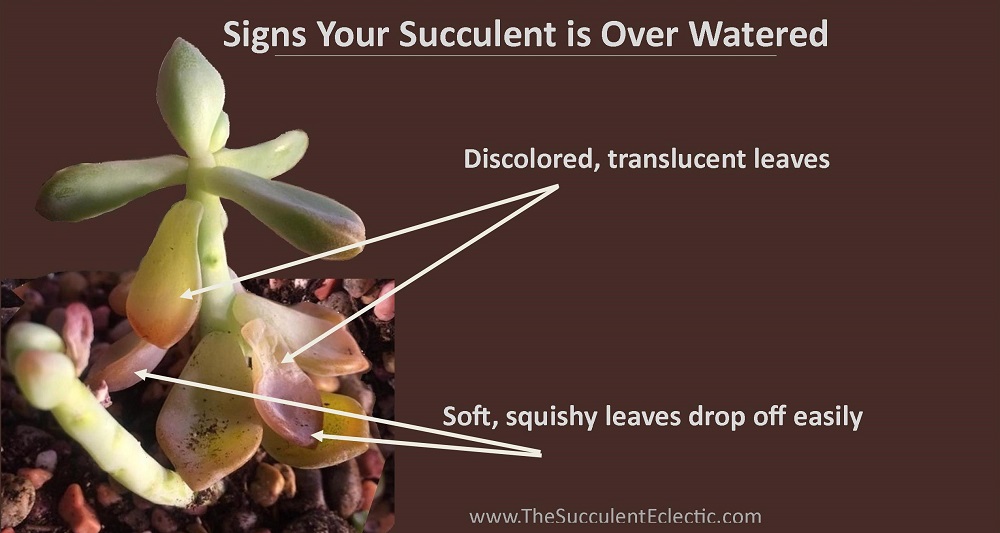
When the plant is overwatered, there is so much water in the soil that the oxygen is driven out, leaving the roots to truly drown. In an effort to regain access to oxygen, the roots take in more and more water, filling the storage cells or water balloons to bursting, resulting in deeply damaged cell structures, and eventually rotting leaves and roots. The first signs of this damage are the leaves becoming soft and squishy, drooping and dropping away easily. The leaves discolor and become partially translucent, as the normal, pigmented cells within have shattered and water fills the leaf.
Unlike the shriveled leaves above, the damage over watering succulents causes is permanent. If you catch it in time, you can cut off the damaged leaves and roots leaving still-healthy plant material to give it an opportunity to rehabilitate. If you rescue the plant from its wet and muddied soil, it is possible to save an overwatered succulent. Or another approach is to take stem cuttings to root and form new plants.
Healthy Succulents with Dried Out Leaves
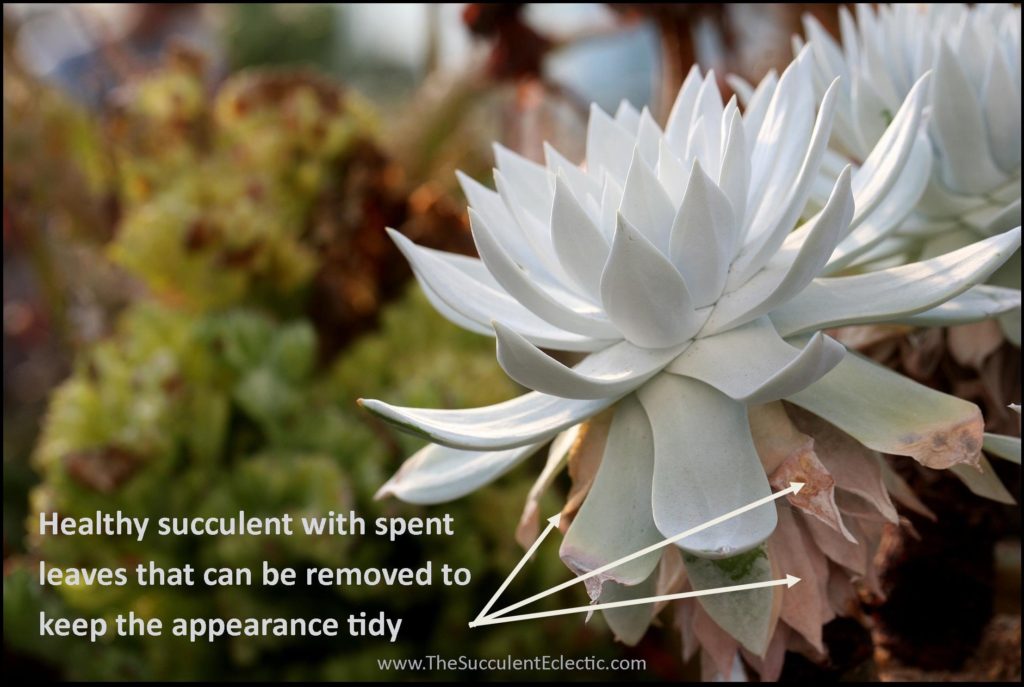
Properly watering succulents is essential for their survival. Your succulent’s health is clearly mirrored in its leaves. Shrunken, shriveled leaves tell you the plant needs water. Squishy leaves losing their coloration shows the plant has been damaged by too much water. But some succulents regularly shut down old leaves as they produce fresh, new leaves as part of their natural growth cycle.
Many succulents will demonstrate this pattern, you often see it with Echeveria, Sempervivums, and other rosette succulents. This is perfectly natural and not a sign of poor health. As older leaves are cut off from new supplies of moisture by the plant, they brown, dry out, become thin and papery. Unlike the shrunken leaves indicating the plant needs water, these leaves do not wrinkle; they just become very thin and papery in texture. They do not become squishy or drop off, and they do not become translucent, like the leaves of an overwatered succulent. The color changes to brown and the plant retains the leaves. You can leave them intact, or remove them for a tidier appearance to suit your preference. Neither affects the health of the plant. Eventually, the plant will slough off these dried leaves.
Dried, papery leaves at the base of the plant give no indication about watering succulents.
Succulents Need Fast Draining Soil
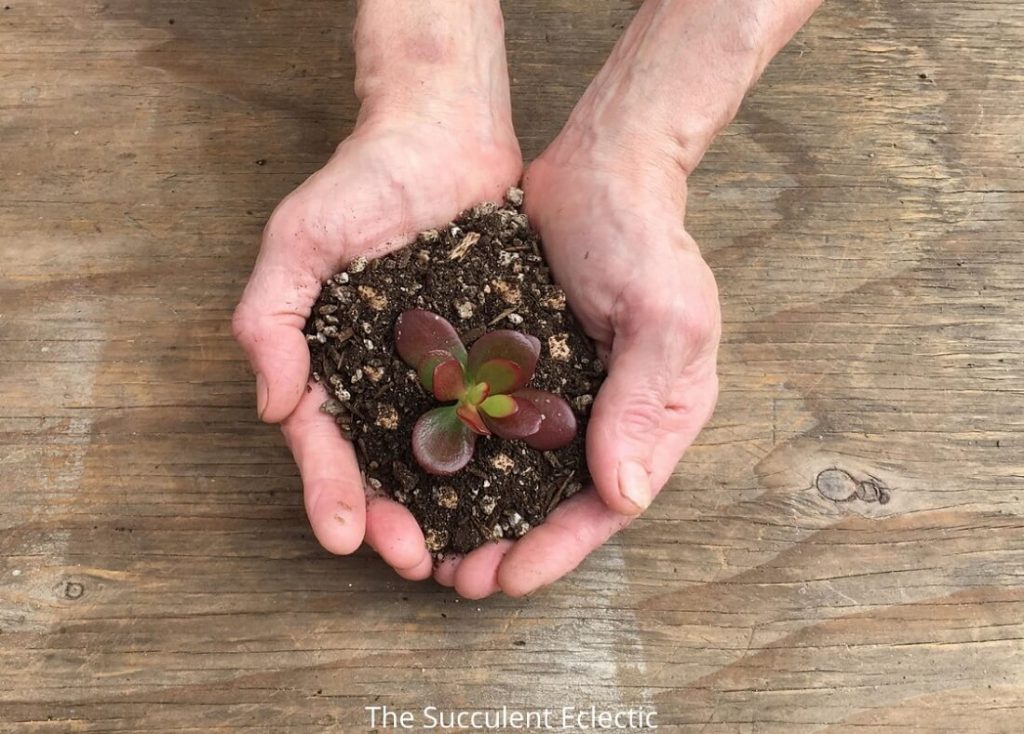
No guide on how to water succulents would be complete without addressing the importance of the proper soil for succulents. Succulents need coarse, gritty soil to ensure fast drainage. The type of soil you use can make or break your succulent’s success. Properly watering succulents is so much easier with the right soil. Whether you make your own mix or purchase cactus and succulent potting mix, the key is to include large, inorganic aggregates to ensure fast drainage and plenty of oxygen in the soil. There are many DIY succulent soil mixes, and all work well. A simple one to try is a 1:1 ratio of potting soil and pumice. A simple test to see if your soil will be suitable for growing succulents is to thoroughly wet a ball of soil and squeeze it in your hand. If it forms a ball that remains when you open your hand, it is retaining too much moisture. You want the soil to crumble away from the ball. Then you know it is ready for succulents!
Learn to make your own succulent soil and how to adjust it for your climate in my detailed blog post. Or skip straight to a collection of succulent soils I recommend.
For the easiest and best results, always choose a container with ample drainage holes. Good drainage makes watering succulents properly so much easier. While you certainly can grow succulents in containers without drainage holes, it is trickier. What to do with the cutest pot that has no holes? Why – drill the drainage holes yourself!
There you have it! A complete guide on How to Water Succulents. I would love to know what you think! Did you learn something new and useful? Do you have any questions? Please take a moment to leave a comment and let me know!
I am happy to answer your questions to help you enjoy the incredible diversity of succulents!
Have a lovely day!
P.S. Please subscribe to The Succulent Eclectic! I’ll send you me FREE e-course 7 Steps to Succulent Success! Thanks!
P.P.S. Why not join my Facebook Group for succulent lovers? We talk about succulent care, propagation, succulent identification, and design. It’s a warm and welcoming group that would love to meet you!
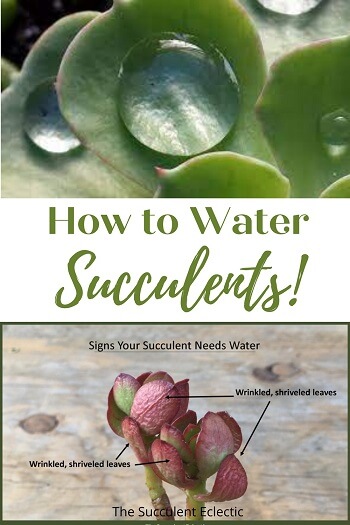
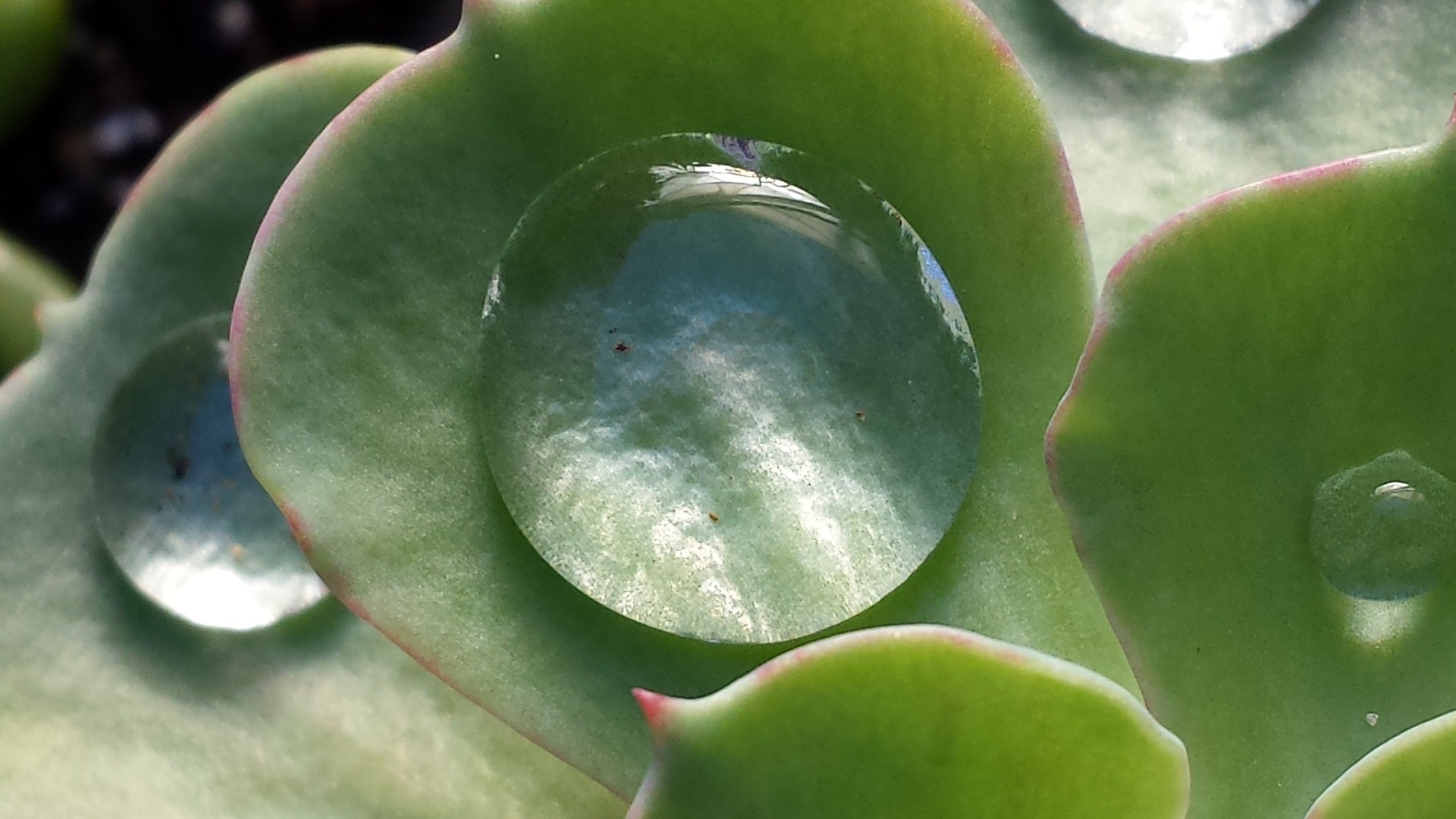
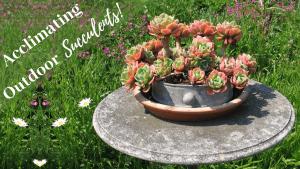
![Read more about the article 7 Simple Succulent Care Tips for Beginners [Infographic]](https://thesucculenteclectic.com/wp-content/uploads/2020/09/7-TIPS-FOR-succulent-beginnersjpg-300x169.jpg)

Hi! So I just got some baby succulents. They were party favors and were not labeled so I have only identified 1 of the 3 types of succulents, it’s called Donkey’s Tail 🤔. They’re planted in a large pot together with a mix of promix, pumice, and sandy soil, decorated with small pebbles on top. How much and how often should I water them? thanks
Hi Eva,
This is why I recommend that you gauge the watering for your succulents by the plants’ leaves. There is no way to tell you to water x amount every y period of time. Without knowing how large the pot is, how large the plants are, what types of succulents, and what your weather (temperatures, humidity and rainfall) are like, it’s impossible to guess.
You are welcome to send me a photo and I can provide more detailed guidance, but judging the health and the needs of your plants will always be your best guide to watering succulents.
You can send me the photo at Kat [at] thesucculenteclectic [dot] com.
Thanks!
~Kat